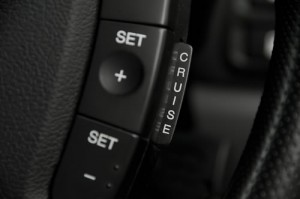 Motor enthusiasts would agree that the luxury vehicles of today, has come a long way since the first automobile of the late 1800’s. With the latest in safety features and comfort, motorists now enjoy effortless driving pleasure.
Motor enthusiasts would agree that the luxury vehicles of today, has come a long way since the first automobile of the late 1800’s. With the latest in safety features and comfort, motorists now enjoy effortless driving pleasure.
One such feature enjoyed by many, is cruise control. Since its launch in the 1900’s, motorists have enjoyed the simplicity of controlling the speed of the vehicle automatically. Despite this, there have been numerous debates on the benefits and risks associated with driving a vehicle with cruise control.
In this article, we will have a closer look at cruise control – how it works, the benefits and risks and how it should be used.
What is cruise control?
Cruise control can be used to automatically control the speed of your vehicle, by taking your foot off the accelerator but you still control the vehicle by steering and braking. It’s a useful tool to prevent driver fatigue, speeding and can even help with improved fuel economy during long trips.
The basic features of cruise control systems
The On/Off Switch: By tapping the ‘On’ button, your vehicle will engage cruise control at a specific speed. By either pressing the brake pedal or by tapping the ‘Off’ button, cruise control will be turned off.
The Set/Accelerate Button: When you tap the ‘Set’ button and remove your foot from the gas pedal, your vehicle will maintain the current speed. If you press ‘Accelerate’, your vehicle will speed up by 1km/h.
Resume Button: This will allow your vehicle to return to the previously programmed speed.
The do’s and don’ts of cruise control
Driving behaviour is very important when using cruise control.
- Don’t use cruise control when the road is wet and slippery. If your wheels begin to skid and you don’t step on the brake to stop, the continued acceleration can cause you to overdrive the road conditions and lose wheel traction and control of the vehicle.
- Don’t use cruise control on hills and winding roads. On hills, it is best to manually control your speed using the accelerator and brake. Cruise control may not accelerate your vehicle properly up a hill, making you a slow‐moving hazard. A steep downhill can cause your vehicle to speed up faster than the cruise control setting and safe road speeds.
- Do keep an eye on your speedometer and manually accelerate and brake as needed. On twisting and winding roads, brake and accelerate into and out of the turns. With cruise control on, you could approach a turn at an unsafe speed and lose control.
It’s important to be alert when driving, even when cruise control is turned on. Fatigue and a false sense of security can lead to a lack of attention on the road ahead, resulting in an accident.